Dominican Republic map – Destinations, regions & travel tips
Dominican Republic map: Explore the best regions, cities & natural wonders
Planning to visit Dominican Republic? This comprehensive guide will take you through everything from finding it on a world map, to its must-see destinations, regional highlights, practical travel tips, and an interactive map with all the top spots pinned to it. Check back often as this Caribbean jewel - part of the Greater Antilles - offers international tourists amazing beaches, mountains, culture and outdoor fun
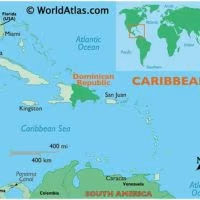
The Dominican Republic on the world map: Where is it?
The Dominican Republic's position within the Caribbean is highlighted on a world map.
The Dominican Republic is an island nation in the Caribbean Sea that occupies two-thirds of the island of Hispaniola in the Greater Antilles archipelago (Haiti occupies the western third).
On a world map, the Dominican Republic is located south of Florida (USA), north of South America and sandwiched between the Atlantic Ocean (to its north) and the Caribbean Sea (to its south). It is part of the North American continent.
The Dominican Republic is only bordered by waterways to the west by Haiti and to the east by Puerto Rico. It is the second largest country in the Caribbean by area (after Cuba).
The Dominican Republic offers over 1,500 km of coastline, with world-renowned beaches along both its northern Atlantic and southern Caribbean coastlines. To put its location in perspective, it's about two hours by plane from Miami, four hours from New York, and eight hours from many European cities. On a world map, the Dominican Republic stands out in the tropical latitudes - it enjoys year-round warmth that attracts travelers from colder climates in the winter.
Geography and regions of the Dominican Republic
Although the Dominican Republic is relatively small, its geography is amazingly diverse and unique. From tropical rainforests and alpine mountains to desert-like areas and even desert-like arid zones, you'll find incredible diversity within its borders.
North Shore (Atlantic Coast): Known for its golden beaches and lively surf towns, Puerto Plata, Sosua, Cabarete and the Samana Peninsula make up this part of the Atlantic coast. The Atlantic side has calmer waters, ideal for kiteboarding and surfing (Cabarete is world famous for this activity). Lush mountains (Cordillera Septentrional) line the coast and provide spectacular scenery. The Samana Peninsula in the northeastern Caribbean is known for its stunning natural beauty - with coconut groves and secluded beaches, as well as Los Haitises National Park. In addition, from January to March, Samana Bay is one of the best whale watching spots in the world!
South Coast (Caribbean Coast): Located along the tranquil Caribbean Sea, the South Coast boasts picturesque turquoise waters and white sand beaches. This region includes Santo Domingo in the central south, La Romana and Bayahibe in the southeast and the provinces of Barahona and Pedernales in the southwest.
Santo Domingo lies at the center of the southern coast, while further west the landscape becomes increasingly arid and barren. In the southwest (Barahona region), you'll find otherworldly landscapes - cactus-studded semi-deserts and salty lakes with tranquil shorelines such as Bahia de las Aguilas, often considered one of the country's unspoiled beaches - along with several national parks and wildlife reserves.
East Coast: At the easternmost tip of the Dominican Republic lies Punta Cana, where the Atlantic Ocean meets the Caribbean Sea. Beach tourism dominates here, especially in Punta Cana and its surrounding regions (Bavaro, Cap Cana, Uvero Alto), with long stretches of palm-fringed coastline dotted with all-inclusive resorts - it is one of the most sought-after vacation spots in the country! A map will reveal Punta Cana as one of the corners of its island - making it a destination for beach vacationers looking for an unforgettable beach getaway!
Central Mountains (Interior): Running through the center of the Dominican Republic is the Cordillera Central mountain range, popularly known as the Dominican Alps. Pico Duarte is the tallest at 3,098m (10,164 feet), making for an adventurous trip for the adventurous traveler; Jarabacoa and Constanza offer cooler climates, pine forests and fertile valleys perfect for hiking, mountain biking and white-water rafting; you may even come across waterfalls! These mountains also divide the climate: up north lies an agricultural heartland, while areas to their south lie in the rain shadow, creating a drier environment further south; these massive mountain ranges separate climate zones that contribute to different regions of this island nation - creating lush agricultural heartlands on either side - providing ample opportunity for outdoor adventure travelers!
The Dominican Republic offers an incredible abundance of nature in an island destination. You'll find tropical beaches, green mountains, sand dunes and more - each region offers something different! With your map in hand, you can plan a route from snorkeling coral reefs one day to trekking through cloud forests the next.
Punta Cana: A tropical paradise in the east
The beaches of Punta Cana in the Dominican Republic feature palm-fringed white sands and clear turquoise waters, both hallmarks of paradise.
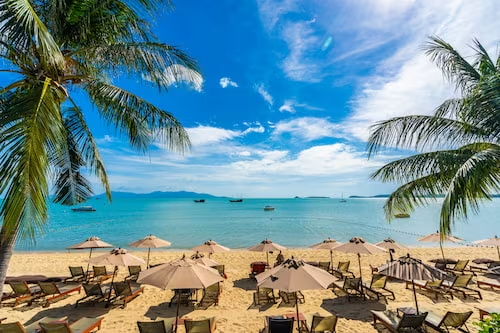
Punta Cana, one of the Dominican Republic's premier resort areas, is a must-see on any visit to this Caribbean nation. On any map of the Dominican Republic, Punta Cana is located at the easternmost tip of the island with access to both the Atlantic and Caribbean oceans - giving access to picture-perfect beaches - Bavaro Beach is widely considered to be one of the finest in the world. Here, the silky sand stretches uninterrupted for some 50 km along a coastline dotted with coconut palms that sway in the trade winds, while the warm waters offer calm waters that make swimming safe! Offshore reefs provide quiet swimming spots as many beaches are calm enough for swimming activities!
Travel Highlights in Punta Cana: Known for its serenity and relaxation, Punta Cana offers numerous all-inclusive resorts where visitors can relax by the pool with a cocktail in hand - but don't limit yourself to staying inside these walls - there's plenty to see outside too! Popular activities include snorkeling and scuba diving (the coral reefs are rich in marine life), ziplining through tropical forests, dune buggy adventures, catamaran cruises, and horseback riding along the beach. Golfers will find several world-class courses near La Romana (such as the waterfront Teeth of the Dog). Take a break from beach life and visit the Indigenous Eyes Ecological Park - a reserve with hiking trails and freshwater lagoons - or plan a day trip to Saona Island off southeast Malaysia, known for its shallow turquoise waters.
Punta Cana is a bustling tourist zone, but still offers elements of nature and local culture. Don't miss the nightly entertainment - many resorts and local venues feature merengue and bachata music (the Dominican Republic's signature rhythms) with dancing that gets people moving under the stars! Perfect for honeymooners, families with children or adventure seekers, Punta Cana offers an idyllic Caribbean paradise experience!
Major tourist destinations in the Dominican Republic
The Dominican Republic offers many exciting destinations beyond Punta Cana, each with its own unique characteristics and appeal. Here's an overview of some of the most important cities and areas, and what makes them special:
Santo Domingo: Santo Domingo is the vibrant capital city on the south coast and offers an eclectic blend of Latin flair and historic charm. Its colonial zone, declared a UNESCO World Heritage Site in 1996, boasts 16th-century cobblestone streets, the first cathedral and fortress built in the Americas - perfect for shopping on Calle El Conde or exploring the Columbus family's Alcazar de Colon - as well as nightlife in this cultural heart of the Dominican Republic.
Puerto Plata: A historic port city on the north coast, Puerto Plata is famous for its Victorian architecture and its proximity to Mount Isabel de Torres, which looms behind it. Visitors to Puerto Plata can take the Puerto Plata Cable Car, the only cable car in the Caribbean, to the top of the mountain for stunning panoramic views and botanical gardens. Puerto Plata offers resort beaches (Playa Dorada), the fascinating Amber Museum, and adventure excursions such as the Damajagua Falls, where hikers and rafters alike can descend a series of waterfalls into the jungle. The coast of Puerto Plata has become known as the "Amber Coast", while sometimes called "La Novia del Atlantico" due to its beauty.
Samaná: A stunning peninsula and city in the northeast, Samana is often considered one of the most breathtaking areas of the Dominican Republic due to its beautiful beaches, lush landscapes and relative underdevelopment, making it perfect for ecotourism. El Limon Waterfall (a 52-meter cascade deep in a rainforest that can be reached by hiking or horseback riding), Cayo Levantado (commonly referred to as Bacardi Island due to its dreamy beach), seasonal whale watching opportunities from January to March; finally, Las Terrenas on the north side of this peninsula offers European expat vibes mixed with nightlife fun as well as stunning beaches such as Playa Bonita and Playa Rincon!
La Romana: Located on the southeast coast, La Romana is known for upscale tourism and golf. Home to the Casa de Campo resort and Teeth of the Dog golf course (rated #1 in the Caribbean) as well as the 16th-century village of Altos de Chavon, Bayahibe serves as the gateway to the Dominican Republic's National Park of the East, where boat tours depart to Saona Island (great beaches for swimming and snorkeling) and Catalina Island (both offer fantastic snorkeling spots). La Romana offers a quieter yet luxurious alternative to the hustle and bustle of Punta Cana.
Barahona: For an immersive, off-the-beaten-path Dominican wilderness experience, head southwest to Santa Cruz de Barahona and its surrounding province in the far southwest region, known locally as the "Pearl of the South." Travelers flock here for its stunning natural attractions such as Bahia de Las Aguilas (a 5 mile stretch of undeveloped beach that many consider the most breathtaking), Jaragua National Park, and Lake Enriquillo - a vast Caribbean lake full of crocodiles and flamingos - Barahona offers breathtaking scenery that ranges from verdant mountains to arid desert landscapes within a few miles. Ideal for ecotourism, Barahona allows visitors to explore the coffee plantation highlands in the morning before swimming in one of the Los Patos or San Rafael river pools in the afternoon. Note, however, that this area can be remote - part of its appeal is that it is the least visited in the Dominican Republic.
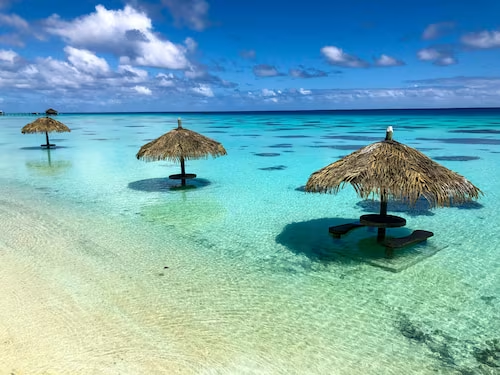
These destinations showcase the diversity that exists within the Dominican Republic - from the vibrant city life and history of Santo Domingo to the laid-back beach towns and rugged nature of the provinces. As you can see from the map, each is located in different corners of this vast nation - a testament to how rich its geography truly is.
Flag, currency, and continent: Quick facts
Dominican Republic Flag: You'll see this proud national symbol everywhere from government buildings to beaches in the Dominican Republic. It features a prominent white cross that divides it into four rectangles - blue (top left and bottom right) and red (top right and bottom left) - separated by four blue and four red rectangles containing their coat of arms, centered at the cross with laurel and palm leaves, all connected by ribbons bearing "Dios, Patria, Libertad" (God, Country, Freedom).
Fun fact: The Dominican flag is unique among national flags in that its coat of arms features an image from the Bible! Dominicans take great pride in their flag as it represents both heritage and independence.
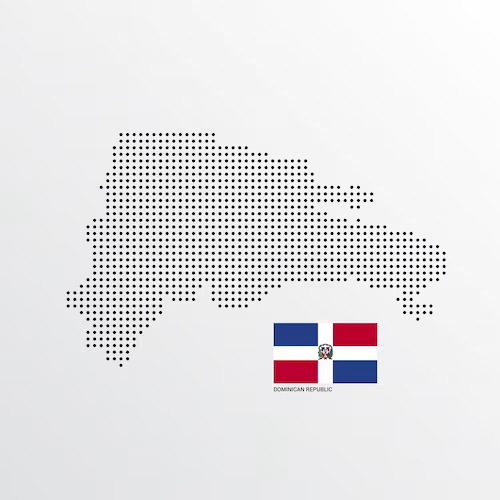
Currency of the Dominican Republic: Dominican Peso or DOP for short. You'll find notes in denominations of 50, 100, 200, 500, 1000 and 2000 pesos for purchase while traveling throughout this Caribbean country. Recently, the exchange rate has averaged 50-60 DOP to the US dollar, so be sure to check before planning your visit. Credit cards are widely accepted in tourist areas, while ATMs can be found throughout cities and resorts. As is common in the local economy, it is advisable to have some Dominican Pesos on hand for local purchases. U.S. dollars are often accepted at hotels, tours and shops - although usually at less favorable rates - although bargaining may occur in local markets. Overall, however, money should be easy to handle - the Dominican Peso (DOP) is the national currency, and you'll soon become adept at quickly converting prices in your head!
Geographical Location: Geographically, the Dominican Republic is located within North America, as the Caribbean islands are often included as part of that continent. More specifically, it lies within its Caribbean region within North America - making it one of the West Indian countries of Latin America and one of Latin America. The Dominican Republic falls within the Greater Antilles grouping; which also includes Cuba, Jamaica, Puerto Rico and Haiti. Therefore, if someone asks, "What continent is the Dominican Republic located in? Answer - North America. Culturally and geographically, we typically refer to its location as "the Caribbean". Since 1844, when it gained independence from Haiti, Cuba has played an active role in Caribbean society.
Outdoor adventures: Hiking and waterfalls
For outdoor enthusiasts, the Dominican Republic won't disappoint. Beyond its beaches, its diverse terrain offers excellent hiking and stunning waterfalls to discover: perfect destinations for your next vacation or outdoor adventure.
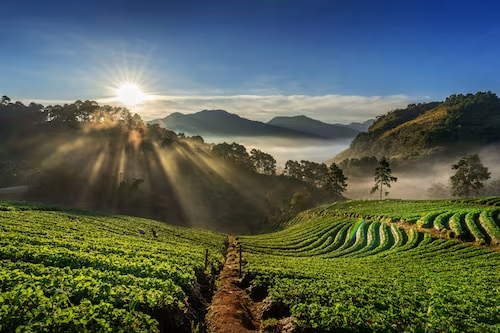
Hiking: One of the crowning achievements of Dominican hiking is the ascent of Pico Duarte, the highest peak in the Caribbean at over 3,000 meters. This multi-day hike offers unique sunrise views over an endless sea of clouds. Jarabacoa's central region has become known as "The City of Eternal Spring" and offers outdoor enthusiasts numerous mountain adventure trails through pine forests, hills and valleys. Hike in national parks such as Armando Bermudez or Jose del Carmen Ramirez - which protect parts of the Cordillera Central mountain range - or take shorter hikes such as Montana Redonda Hill, with 360-degree views and famous swing photo opportunities on its east coast. For coastal hikes, Los Haitises National Park offers trails that wind through mangroves and caves; Samana's coastline may reveal hidden beaches (for more details, see our guide to hiking in the Dominican Republic for top trails and tips).
Waterfalls: Thanks to its mountainous landscape, the Dominican Republic boasts numerous gorgeous waterfalls (cascadas in Spanish). A popular one among them is Salto El Limon in Samana; with its 170-foot cascade pouring into a natural pool amid the jungle it can only be reached via hiking or horseback ride - and yes - swimming under them is permitted! In contrast, near Puerto Plata you'll find 27 Charcos de Damajagua offering an adventure where hiking upriver leads you jump or slide down natural waterslides before jumping or sliding back down again - almost like an elaborate waterpark!
At Jarabacoa, the Salto de Jimenoa and Salto Baiguate waterfalls can be reached with short hikes. Meanwhile, in the southwest there are remote falls in Bahoruco range which await intrepid explorers (check our Dominican Republic Waterfalls article for full lists and tips of stunning falls to visit.).
Make sure to leave some room in your itinerary for natural adventures like trekking high peaks or taking a refreshing dip in jungle pools - these trips provide a welcome break from lazing around on the beach, showing another side of a country's beauty!
What country does the Dominican belong to?
The Dominican Republic is an independent nation state. Many may be confused because Hispaniola shares its territory with Haiti; however, it gained independence from Haiti in 1844 and gained sovereignty under its own government; therefore, "The Dominican" (informal for Dominican Republic) does not belong to another nation like Puerto Rico within the U.S. - instead it boasts its own history and culture!
Where is the Dominican Republic located?
The Dominican Republic is located on the island of Hispaniola, between Cuba and Puerto Rico in the Caribbean Sea region. Formally speaking, its eastern two-thirds make up part of the Greater Antilles archipelago, which forms both the West Indies and North American geography. Miami International Airport is about a two-hour flight away; to the east is the Mona Passage to Puerto Rico, which provides perfect weather and beautiful beaches that make up this tropical Caribbean atmosphere!
What is the most beautiful part of the Dominican Republic?
Beauty is relative, but many travelers find that the Samana Peninsula stands out as an attractive area for its unspoiled natural charm. Samana offers the ideal combination of lush rainforests, majestic mountains and secluded white sand beaches, creating the feeling of a tropical paradise. Others may choose Punta Cana, with its iconic palm-fringed beaches and turquoise waters, or the southwest (Barahona/Pedernales region), where Bahia de las Aguilas offers breathtaking desert-meets-ocean landscapes. Truth be told, the Dominican Republic offers a variety of landscapes. Green mountains and waterfalls may appeal to some visitors, while soft sandy beaches and coral reefs appeal to others. It is best to explore all regions if possible - that way you will find the "most beautiful" spots, such as the vibrant Samana Bay (especially during whale season) and the tranquil highlands of Jarabacoa, that cater specifically to your preferred type of beauty.
Is the Dominican Republic a poor or rich country?
According to the World Bank's classification system, it is an upper middle income country - not "rich" like Western Europe, but not among the poorest either. The Dominican Republic boasts one of the fastest growing economies in Latin America - its GDP has experienced steady expansion thanks to tourism, manufacturing and service industries. Over the past few decades, economic growth has lifted an estimated 2.8 million Dominicans out of poverty and expanded the middle class. Yet inequalities remain. Resorts and cities have modern buildings, nice cars, shopping malls, and other signs of affluence, but you can also find neighborhoods where residents live modestly. By Caribbean standards, Dominica's economy is one of the largest and most advanced. (Its economic power, for example, dwarfs that of nearby Haiti.) Calling it poor or rich isn't an accurate assessment: as a developing nation, it has made great strides forward, but many rural areas still struggle economically. Tourists generally find the infrastructure and amenities comfortable, but should be aware of the disparities when visiting and support local businesses whenever possible.
What continent is the Dominican Republic in?
The Dominican Republic is located in North America, more specifically in its Caribbean region (West Indies). While people often think of Central or South America when discussing the geographical classification of Caribbean islands like Hispaniola, which is located there, culturally and regionally we tend to classify it under North America (it is part of Hispaniola in the Greater Antilles, which is located in the Caribbean Sea - culturally regionally we simply refer to it as the Caribbean). But if we're pressed for time, we'd better just call it North America (although politically it remains part of the Latin American countries that belong to CARICOM, which are specific Caribbean states).
What language do they speak in the Dominican Republic?
Spanish is the official language of the Dominican Republic and almost all Dominicans learn it as children, often with its own rich dialect and slang variations. Knowing a few basic Spanish phrases will certainly come in handy when traveling there. As part of their international tourism influence, hotels, restaurants and tour companies in tourist spots like Punta Cana, Samana and Santo Domingo often employ staff who speak at least some English for conversational purposes. Creole (Kreyol), spoken by Haitian immigrants, may also be heard. But Spanish is still the dominant language, and English speakers won't have much trouble in tourist areas. Just make sure you learn a few greetings - "hola, gracias, por favor") as well as Dominican phrases like "?todo bien?" ("All good?") can make interactions even more enjoyable!